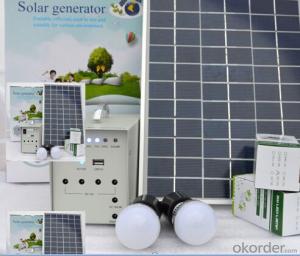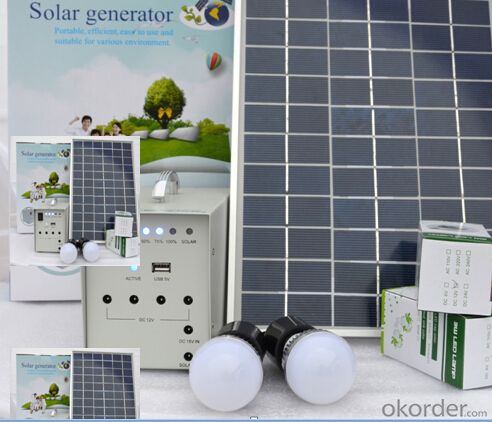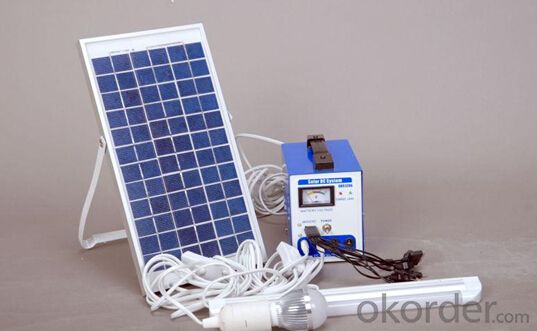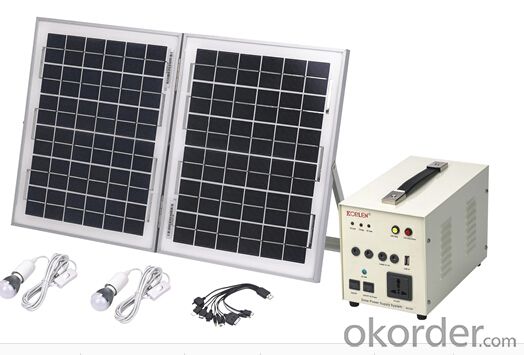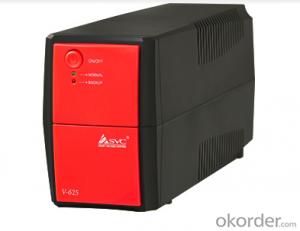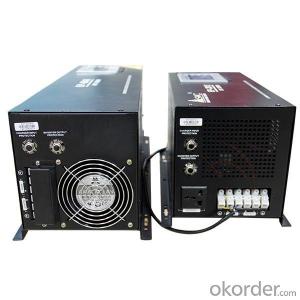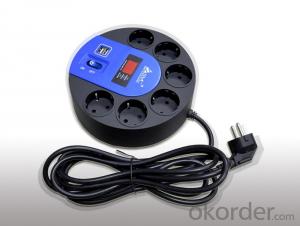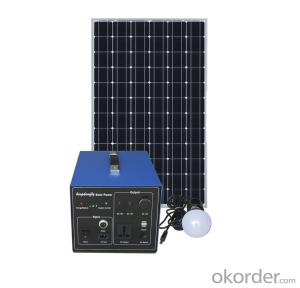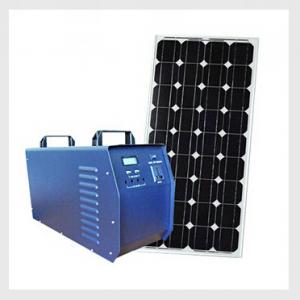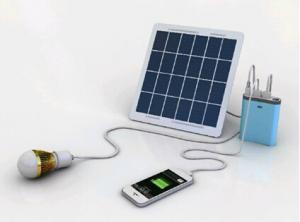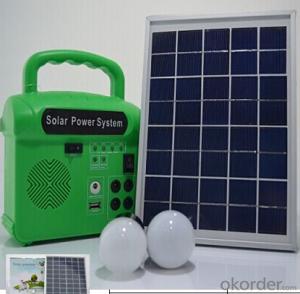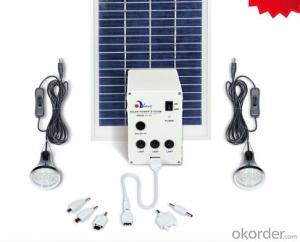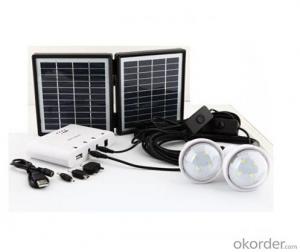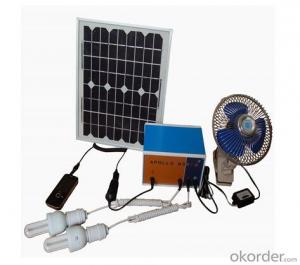CNBM Solar Home System Roof System Capacity-5w - Solar Energy Systems Coimbatore
- Loading Port:
- Shanghai
- Payment Terms:
- TT or LC
- Min Order Qty:
- 5 unit
- Supply Capability:
- 500000 unit/month
OKorder Service Pledge
OKorder Financial Service
You Might Also Like
Introduction of Solar Home System
Solar Home System is composed by Solar Panels, Inverters, Charger Controller, Battery, Cable, Mounting Bracket, which is applied to produce electricity for home use.
Solar Home System is quite suitable product in urban area and the place which is short of electricity. Our Small Solar Home System own great benifits compare with other kind electricity resources:
Electricity generating cost of Solar Home System is much cheaper than diesel engine. Beside low electricity making cost, solar system products also have the features of noiseless, clean energy, environmentally friendly and can access to many different electric appliance.
Working Principle of Solar Home System
The stand alone Solar Home System is an off-grid solar system which uses batteries to store the solar energy. Stand alone solar system solutions design for those who are not able or willing to connect to electricity grid.
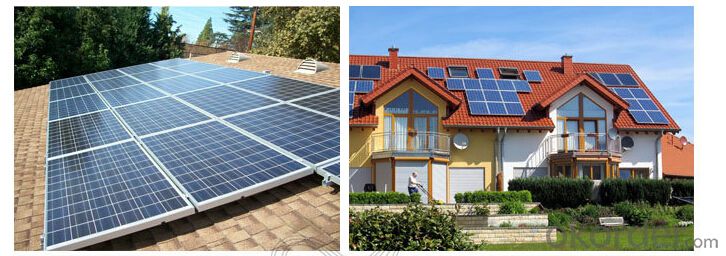


Specification of Solar Home System
Names of Modules | Parameters | Package Specification |
Poly-crystalline Silicon Solar Panel | 18V/5W 245*185*18MM | Package:1 set/box
Encasement:4 sets/ctn
Color Box Size:230*163*310MM Carton Size:475*335*330MM
NW3.04kg/
GW:3.55 kg/set |
Lead Acid Battery | 12V/4AH | |
Controler | 12V/3A | |
Control Box Size | 115*95*148MM | |
LED Light | 3W/6V/12V 2pcs | |
Light Wire | M/24# | |
Solar Panel Line | M/24# | |
Output | 5V/12V |
Advantage of Our Solar Home System
1 Excellent Performance: Our Solar Home System is composed by Brand Standard Kits with high quality. Our solar system has the advantage of high efficiency and stable operation. We can ensure our product with a long life period.
2. Small Orders Accepted: We can accept small orders as our customer’s trial order.
3. Warehouse: We have warehouse overseas which can bring great convenience to our customer to pick up the products.
Terms and Conditions
1. Trade terms: FOB Shanghai
2. Payment terms: 30% T/T, balanced before shipment/ LC at sight before shipment. Actual Terms can be negotiated for big order.
3. Package: Exported standard package suitable for tough handling and sea transport.
4. Delivery: Goods to be ready within 10~30 days depending on order quantity.
5. Warranty: 10 years for solar panel, 2 years for controller/inverter/battery.
FAQ
Q: Could you introduce the background of your company?
A: We are a Group corp. with 1GW capacity in China, which is Okorder’s registered VIP Supplier, possess Financial Service from Okorder.com.
Q: Required mainly certificates (CE&IEC/TUV/RoHS)?
A: Our products are certificated by CE RoHS, IEC, ISO, TUV, UL etc.
Q: Your main exported market is?
A: Main markets of our products is: South-east Asia, Mid-east, Arica, East Europe and Latin America.
- Q: Do solar energy systems require regular panel replacements?
- Panel replacements are not required for solar energy systems. Solar panels are designed to be durable and long-lasting, lasting on average 25 to 30 years. It's important to note that over time, the efficiency of the panels may decrease slightly, typically around 0.5% to 1% per year. This means that after 25 years, the panels may still be functional, but they may produce slightly less power than when initially installed. To prolong the life and optimize performance, regular maintenance and cleaning are important. As long as the panels are well-maintained and undamaged, they can reliably generate electricity for many years without needing replacements.
- Q: Are there any risks of electrical arcing with solar energy systems?
- Yes, there are risks of electrical arcing with solar energy systems. Electrical arcing occurs when there is a breakdown in the insulation of electrical components, resulting in the flow of electricity through air or other non-conductive materials. This can lead to a fire hazard and damage to the solar energy system. Some potential causes of electrical arcing in solar energy systems include faulty wiring, loose connections, and damage to the solar panels. These issues can result in an increased risk of electrical arcing, which can cause overheating, melting of components, and even electrical fires. To mitigate the risks of electrical arcing, it is crucial to ensure that the solar energy system is installed and maintained by qualified professionals who follow industry standards and regulations. Regular inspections and maintenance should be conducted to identify and address any potential issues that could lead to electrical arcing. Furthermore, the use of high-quality electrical components and proper grounding techniques can help reduce the risk of electrical arcing. Implementing safety measures such as circuit breakers, surge protectors, and arc fault circuit interrupters (AFCIs) can also provide additional protection against electrical arcing. In summary, while solar energy systems offer numerous benefits, it is important to be aware of the potential risks of electrical arcing. By ensuring proper installation, maintenance, and adherence to safety guidelines, the risks can be minimized, allowing for the safe and efficient operation of solar energy systems.
- Q: How do solar energy systems handle excess energy production?
- Excess energy generated by solar energy systems can be managed in several ways. One way is through net metering, which involves feeding back any surplus energy produced by the solar system into the grid. This surplus energy is then credited to the homeowner's account, causing their meter to spin backward and ultimately reducing their energy bill. Another approach to handling excess energy production is the utilization of battery storage systems. These systems enable homeowners or businesses to store any extra energy generated by their solar panels. The stored energy can then be used during periods of high energy demand or when the sun is not shining, such as the evening or cloudy days. This maximizes the efficiency and value of the solar system. Additionally, certain solar energy systems are designed to automatically shut down or reduce their output when there is an excess of energy being produced. This strategy, known as curtailment, is commonly implemented in large-scale solar farms or utility-scale installations. By decreasing the output in these situations, the surplus energy is not wasted and can be managed and distributed more effectively. In summary, solar energy systems employ various methods, including net metering, battery storage, and curtailment, to effectively handle excess energy production. These mechanisms ensure that the surplus energy is not wasted and can be efficiently utilized, showcasing solar energy as a sustainable and highly efficient power source.
- Q: Can solar energy systems be used in powering beauty salons or spas?
- Certainly, beauty salons and spas can utilize solar energy systems to effectively power their establishments. Solar energy is a source of power that is both renewable and sustainable, enabling these establishments to decrease their reliance on traditional electricity and minimize their carbon footprint. Installation of solar panels on the rooftop or other suitable areas allows beauty salons and spas to generate their own electricity, resulting in long-term cost savings. Beauty salons and spas typically have high electricity requirements for operating various equipment such as hair dryers, hair straighteners, curling irons, lighting, and air conditioning. Solar energy systems are capable of meeting these power demands, particularly during daylight hours when the sun is shining. Any excess electricity generated during the day can be stored in batteries or directed back into the grid, ensuring a continuous and reliable power supply. Furthermore, by adopting solar power, beauty salons and spas can enhance their sustainability and environmental performance. This transition to solar energy enables these establishments to significantly reduce their carbon emissions and actively contribute to the global fight against climate change. Additionally, the use of solar energy can attract environmentally conscious customers who value businesses that prioritize sustainability. To summarize, solar energy systems present a viable solution for powering beauty salons and spas. They provide a dependable and sustainable source of electricity, while also offering cost savings and supporting greener and more environmentally friendly business practices.
- Q: Can solar energy systems be used in powering warehouses or distribution centers?
- Solar energy systems are indeed capable of powering warehouses and distribution centers. Many businesses are increasingly adopting solar energy as a sustainable and cost-effective solution for their energy requirements. Warehouses and distribution centers, being large facilities with ample roof space, are ideal candidates for solar panel installations. By installing solar panels on the roof or ground of these facilities, the solar energy generated can be utilized to power various operations within the warehouse or distribution center. This includes lighting systems, climate control, refrigeration units, conveyor belts, and other machinery or equipment. The energy generated can also be stored in batteries for later use during cloudy days or at night. There are several advantages that make solar energy systems a perfect fit for warehouses and distribution centers. Firstly, solar power helps reduce dependence on the traditional grid, resulting in lower electricity bills and long-term cost savings. Additionally, since solar energy is a renewable and clean source, its use reduces greenhouse gas emissions and contributes to a more sustainable business operation. Besides the cost and environmental benefits, solar energy systems offer businesses energy independence and resilience. By generating their own power, warehouses and distribution centers are less susceptible to power outages or fluctuations in the grid, ensuring uninterrupted operations and minimizing downtime. In conclusion, the use of solar energy systems in powering warehouses and distribution centers offers numerous advantages, including cost savings, sustainability, energy independence, and operational resilience. Consequently, an increasing number of businesses are embracing solar energy as a reliable and efficient solution for their energy needs in these types of facilities.
- Q: What is the role of solar inverters in converting DC to AC power?
- The role of solar inverters is to convert the direct current (DC) power generated by solar panels into alternating current (AC) power that can be used by electrical devices and fed into the grid.
- Q: Can solar energy systems be used in areas with limited access to solar energy insurance coverage?
- Yes, solar energy systems can still be used in areas with limited access to solar energy insurance coverage. While insurance coverage is important for protecting investments in solar energy systems, it is not a prerequisite for their installation and operation. In such areas, other risk management strategies, such as regular maintenance, warranties, and proper installation, can be employed to mitigate potential risks and ensure the longevity and performance of the solar energy systems. Additionally, exploring alternative financing options or seeking government assistance may be helpful in making solar energy more accessible and affordable in areas with limited insurance coverage.
- Q: Are there any safety certifications required for solar energy systems?
- Yes, there are safety certifications required for solar energy systems. The most common certification is the UL 1703, which ensures that the solar panels meet specific safety and performance standards. Additionally, some states and countries may have their own certification requirements for solar installations to ensure compliance with local safety regulations.
- Q: Can solar energy systems be installed on airports or transportation hubs?
- Yes, solar energy systems can be installed on airports or transportation hubs. In fact, many airports around the world have already embraced solar power as a clean and sustainable energy source. These systems can be installed on rooftops, parking lots, or even as ground-mounted arrays near the facilities. Solar energy can help airports and transportation hubs reduce their carbon footprint, lower energy costs, and contribute to a greener and more sustainable future.
- Q: Can solar energy systems be connected to the existing power grid?
- Yes, solar energy systems can be connected to the existing power grid. This is known as grid-tied or grid-connected solar systems. When connected, excess electricity generated by the solar panels can be fed back into the grid, allowing homeowners or businesses to earn credits or receive compensation for the power they produce.
Send your message to us
CNBM Solar Home System Roof System Capacity-5w - Solar Energy Systems Coimbatore
- Loading Port:
- Shanghai
- Payment Terms:
- TT or LC
- Min Order Qty:
- 5 unit
- Supply Capability:
- 500000 unit/month
OKorder Service Pledge
OKorder Financial Service
Similar products
Hot products
Hot Searches
Related keywords
